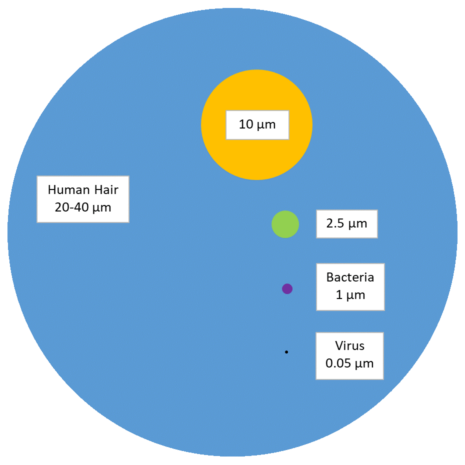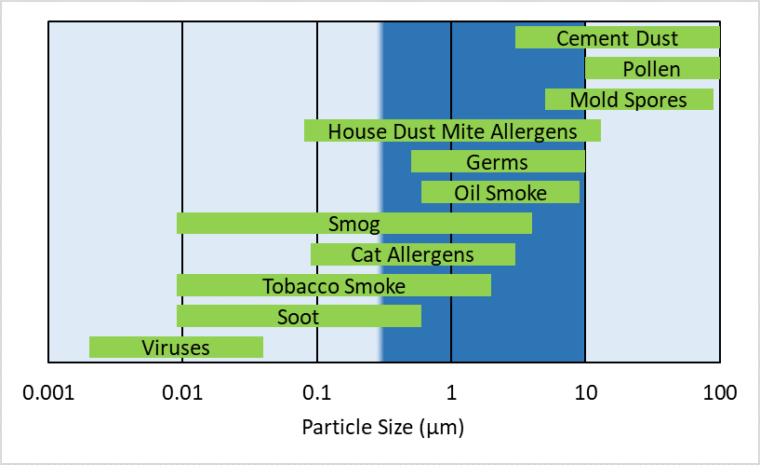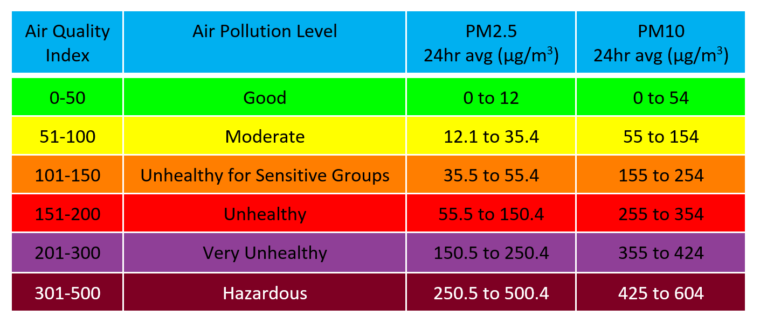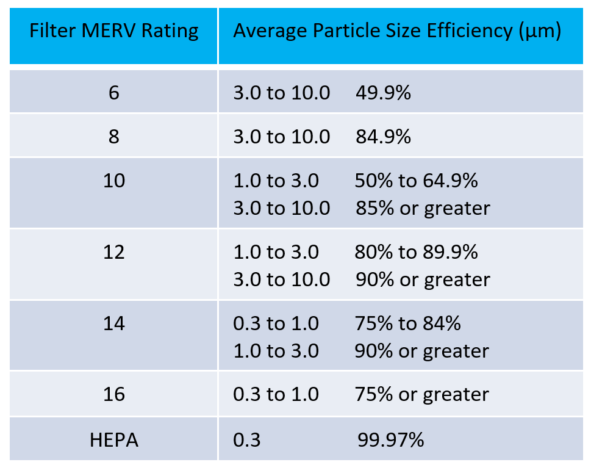
BAPI makes a laser-based particulate matter sensor that will measure particle concentrations from 0 to 1,000 µg/m3, with field selectable particle sizes of PM1.0, PM2.5 and PM10. This App Note provides an overview of particulate sizes as well as common particulates in each size range.
What is Particulate Matter?
Particulate Matter (PM) is often referred to as dust, but it is more than the common dust that settles on your flat screen TV. The Environmental Protection Agency (EPA) defines it as a mixture of solid particles and liquid droplets found in the air. Although most particulates are not in the shape of a circle, “diameter” is often used to describe the size of particulates.
The EPA and other world organizations track two sizes of particulate matter: PM10 and PM2.5.
• PM10 consists of particulates that are ≤10 µm in diameter
• PM2.5 consists of particulates that are ≤2.5 µm in diameter
As a reference, 1 micrometer (µm) = 1 micron or 0.000001 meters.

The diagram shows some relative sizes. The large blue circle is a single strand of human hair.

The chart identifies some common particulates and their relative sizes. The dark shaded area shows the measurement range for current commercial particulate sensors (0.3 to 10 µm).
Why Does Particulate Size Matter?
According to the EPA’s website, “The size of particles is directly linked to their potential for causing health problems. Small particles less than 10 micrometers in diameter pose the greatest problems, because they can get deep into your lungs, and some may even get into your bloodstream.”
During their last Integrated Science Assessment (ISA) in December of 2019, the EPA reconfirmed that exposure to particulates in the PM2.5 range has both respiratory and cardiovascular effects. The EPA believes that particles in the range of PM10 might also have respiratory and cardiovascular effects, but because there are so few studies on the effects in the PM10 range, there is not enough evidence to state it. The EPA’s website (www.epa.gov/pm-pollution) is a good source for additional information.
As you would expect, increased levels of particulates in the PM2.5 range are most damaging to people with lung or heart diseases as well as children and older adults. But it’s not just your health that can be affected. Recent studies suggest that increased levels of particulates in the PM2.5 range negatively impact worker productivity, physical activity and cognitive functions.
The current field of commercial particulate sensors cannot detect viruses because of their extremely small size. Some studies indicate that viruses have the potential to piggyback on larger particulates that the sensor can detect. However, the particulate sensor cannot differentiate between a particle that may contain a virus and one that does not.
Is Monitoring of Particulate Matter Required?
The Clean Air Act requires the EPA to set standards for the quality of the air in the United States, and government agencies in many other parts of the world have similar requirements. Particulate matter is one of the substances that requires monitoring by these air quality standards. Many websites provide current data for the outdoor air quality levels throughout the world. Below are two such websites with maps for geographic regions.
• U.S. Map: www.airnow.gov
• World Map: www.aqicn.org
The 2019 revision of ASHRAE Standard 62.1 has some requirements for particulates in the PM10 and PM2.5 range. The standard does not specifically require a PM sensor, but it does say that the air must be filtered appropriately and lists some specific MERV (Minimum Efficiency Reporting Values) filter ratings for the two PM size ranges. The two paragraphs below are copied from the standard.
ASHRAE Standard 62.1-2019
6.1.4.1 – Particulate Matter Smaller than 10 Micrometers (PM10). In buildings located in an area where the national standard or guideline for PM10 is exceeded, particulate filters or air-cleaning devices shall be provided to clean the outdoor air at any location prior to its introduction to occupied spaces. Particulate matter filters or air cleaners shall have either
a. A MERV of not less than 8 where rated in accordance with ASHRAE Standard 52.2 or
b. The minimum efficiency within ISO ePM10 where rated in accordance with ISO 16890.
6.1.4.2 – Particulate Matter Smaller than 2.5 Micrometers (PM2.5). In buildings located in an area where the national standard or guideline for PM2.5 is exceeded, particulate filters or air-cleaning devices shall be provided to clean the outdoor air at any location prior to its introduction to occupied spaces. Particulate matter filters or air cleaners shall have either
a. A MERV of not less than 11 where rated in accordance with ASHRAE Standard 52.2 or
b. The minimum efficiency within ISO ePM2.5 where rated in accordance with ISO 16890.
Monitoring PM levels is one of the requirements for achieving many of the 3rd party building certifications. All five of the certifications listed below include PM10 and/or PM2.5 in their requirements.
• Fitwel
• LEED
• Living Building Challenge
• RESET
• WELL
How Do I Use the Particulate Matter Sensor Output?
Neither ASHRAE nor the EPA dictates what should be done with ventilation rates when PM levels increase. The EPA does provide the below recommendations for what levels are healthy. Both Europe and China have similar charts. BAPI’s particulate sensor provides an output that is scaled from 0 to 1,000 µg/m3. You can compare this output against the EPA Air Quality Index Chart below and decide where to set your trigger points. That’s the easy part.

The hard part is deciding what action to take if the particulate level exceeds your trigger point.
• Do you notify the building occupants?
• Do you increase or decrease the ventilation rate?
• Do you investigate or upgrade the filtration system?
To make this decision, you should trend the particulate levels for several weeks or several months without making system adjustments to understand what “normal” is. Generally, particulate levels are higher outdoors than they are in a building. A common exception is a church where burning candles may cause the inside particulate level to be greater than the outside level. CO2 and VOC levels are the opposite in that they are normally higher inside the building.
For CO2 and VOC, increasing the outside air ventilation rate is the typical way to reduce the readings to acceptable levels. For particulates, simply bringing in more ouside air may actually make the situation worse if your filtration system isn’t properly removing the particulates. This can happen if the filters are dirty or if the MERV ratings are too low.
As mentioned earlier, ASHRAE requires a minimum MERV 11 filter for particulates in the PM2.5 range. The chart below shows the particle size filtration efficiency for various MERV ratings. Just like panel or bag filters, electrostatic filters span a wide range of efficiencies depending on the manufacturer. Some electrostatic filters get close to the HEPA filter rating while others are much less than that.

Installation Tip
The BAPI Particulate Matter sensor has an internal fan that draws air through a laser beam to count and measure the particles. The accuracy of the sensor relies on the velocity of the air flowing through the sensor to remain relatively constant. Avoid installing the sensor in an airstream that is greater than 1 m/s (195 fpm) by keeping it away from fans, diffusers, windows, etc.
If you have additional questions, please call your BAPI representative.



